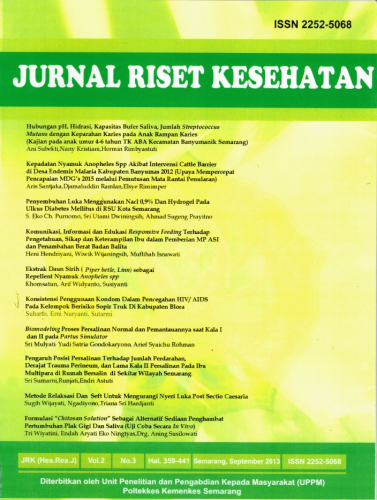PERBANDINGAN PENGUKURAN STATUS SEDASI RICHMOND AGITATION SEDATION SCALE (RASS) DAN RAMSAY SEDATION SCALE (RSS) PADA PASIEN GAGAL NAFAS TERHADAP LAMA WEANING VENTILATOR DI GICU RSUP Dr.HASAN SADIKIN BANDUNG
Abstract
Sedation is an important factor to improve patient comfort. Over sedation may lead to a longer ventilator time. To prevent over sedation need an instrument can measure accurately the status of sedation. This study aimed to analyze the differences between Richmond Agitation Sedation Scale (RASS) and the Ramsay Sedation Scale (RSS) in measuring the status of sedation for respiratory failure patient against time weaning ventilator. This study is observational analytic with prospective cohort study.
This study was conducted in 13 respiratory failure patient and use mechanical ventilator. Sampling is done by non probability sampling method with consecutive sampling that received sedation therapy in GICU RSUP Dr Hasan Sadikin, Bandung. Samples will be measured with two sedation instrument they are RASS and RSS. Patient will be observed until the patient is successfully weaning ventilator mode CPAP or CPAP PS with PS 5-8 cmH2O and PEEP 5 cmH2O.
These results indicate the measurement status with RASS sedation and RSS have a significant impact on weaning ventilator time with a value of p less than 0.05. Based on analysis results there is a significant difference between the measurement of sedation status by RASS and RSS for respiratory failure patient and weaning ventilator time with p less than 0.05, and the post hoc analysis shows that there are differences in each measurement sedation with p less than 0,05.
Measurement status with RASS sedation better in reducing the length of ventilator weaning compared to RSS. This study can be used as the basis for further research regarding the relationship status measurement sedation to morbidity, mortality and length of stay in patients receiving sedation therapy.
Keywords
Full Text:
PDFReferences
American Association of Nurse Anaesthetists. (2008). Scope and standards for nurse anesthesia practice.
Barr, J., Fraser, G. L., Puntillo, K., Ely, E. W., Gélinas, C., Dasta, J. F., ... & Jaeschke, R. (2013). Clinical practice guidelines for the management of pain, agitation, and delirium in adult patients in the intensive care unit: Executive summary. Am J Health Syst Pharm, 70(1), 53-58.
Boles, J. M., Bion, J., Connors, A., Herridge, M., Marsh, B., Melot, C., ... & Welte, T. (2007). Weaning from mechanical ventilation. European Respiratory Journal, 29(5), 1033-1056.
Brandl, K. M., Langley, K. A., Riker, R., Dork, L. A., Qualls, C. R., & Levy, H. (2001). Confirming the Reliability of the Sedation‐Agitation Scale Administered by ICU Nurses without Experience in Its Use. Pharmacotherapy: The Journal of Human Pharmacology and Drug Therapy, 21(4), 431-436.
Brattebo, G., Hofoss, D., Flaatten, H., Muri, A. K., Gjerde, S., & Plsek, P. E. (2002). Quality improvement report: Effect of a scoring system and protocol for sedation on duration of patients' need for ventilator support in a surgical intensive care unit. BMJ: British Medical Journal, 324(7350), 1386.
Consales, G., Chelazzi, C., Rinaldi, S., & De Gaudio, A. R. (2006). Bispectral Index compared to Ramsay score for sedation monitoring in intensive care units. Minerva anestesiologica, 72(5), 329-336.
Conti, G., Mantz, J., Longrois, D., & Tonner, P. (2014). Sedation and weaning from mechanical ventilation: time for ‘best practice’to catch up with new realities?. Multidisciplinary respiratory medicine, 9(1), 45.
Dawson, R., Fintel, N. V., & Nairn, S. (2010). Sedation assessment using the Ramsay scale: Rachel Dawson and colleagues review the reliability of tools for assessing sedation and how these differ from methods of measuring consciousness. Emergency Nurse, 18(3), 18-20.
Ely, W. E., Truman, B., Shintani, A., Thomason, J. W., Wheeler, A. P., Gordon, S., et al. (2003). Monitoring Sedation Status Over Time in ICU Patients. Intensive Care medicine, 289(22). doi:10.1001/jama.289.22.2983.
Ennis, K. M., & Brophy, G. M. (2011). Management of Intracranial Hypertension: Focus on Pharmacologic Strategies. AACN advanced critical care, 22(3), 177-182.
Franca, S. A., Toufen Junior, C., Hovnanian, A. L. D., Albuquerque, A. L. P., Borges, E. R., Pizzo, V. R., & Carvalho, C. R. R. (2011). The epidemiology of acute respiratory failure in hospitalized patients: a Brazilian prospective cohort study. Journal of critical care, 26(3), 330-e1.
Girard, T. D., Kress, J. P., Fuchs, B. D., Thomason, J. W., Schweickert, W. D., Pun, B. T., ... & Ely, E. (2008). Efficacy and safety of a paired sedation and ventilator weaning protocol for mechanically ventilated patients in intensive care (Awakening and Breathing Controlled trial): a randomised controlled trial.The Lancet, 371(9607).
Grap, M. J., Munro, C. L., Wetzel, P. A., Best, A. M., Ketchum, J. M., Hamilton, V. A., ... & Sessler, C. N. (2012). Sedation in adults receiving mechanical ventilation: Physiological and comfort outcomes. American Journal of Critical Care, 21(3).
Hernandez-Gancedo, C., Pestana, D., Pena, N., Royo, C., Perez-Chrzanowska, H., & Criado, A. (2006). Monitoring sedation in critically ill patients: bispectral index, Ramsay and observer scales. European journal of anaesthesiology, 23(08), 649-653.
Ismaeil, M. F., El-Shahat, H. M., El-Gammal, M. S., & Abbas, A. M. (2014). Unplanned versus planned extubation in respiratory intensive care unit, predictors of outcome. Egyptian Journal of Chest Diseases and Tuberculosis,63(1), 219-231.
Jakob, S. M., Lubszky, S., Friolet, R., Rothen, H. U., Kolarova, A., & Takala, J. (2007). Sedation and weaning from mechanical ventilation: effects of process optimization outside a clinical trial. Journal of critical care, 22(3).
Lutz, A., & Spies, C. (2011). ICU delirium: Consequences for management of analgesia and sedation in the critically ill. Anasthesiologie, Intensivmedizin, Notfallmedizin, Schmerztherapie: AINS, 46(9), 568-572.
Martin, J., Heymann, A., Bäsell, K., Baron, R., Biniek, R., Bürkle, H., ... & Spies, C. (2010). Evidence and consensus-based German guidelines for the management of analgesia, sedation and delirium in intensive care–short version. GMS German Medical Science, 8.
Mendes, C. L., Vasconcelos, L. C. S., Tavares, J. S., Fontan, S. B., Ferreira, D. C., Diniz, L. A. C., ... & Silva, S. L. D. D. (2008). Ramsay and Richmond's scores are equivalent to assessment sedation level on critical patients. Revista Brasileira de terapia intensiva, 20(4), 344-348.
Prottengeier, J., Moritz, A., Heinrich, S., Gall, C., & Schmidt, J. (2014). Sedation assessment in a mobile intensive care unit: a prospective pilot-study on the relation of clinical sedation scales and the bispectral index. Critical Care, 18(6), 615.
Ramsay, M. A., Nasraway Jr, T. A., Wu, E. C., Kelleher, R. M., Yasuda, C. M., Donnelly, A. M. (2002). How reliable is the bispectral index in critically ill patients? A prospective comparative single-blinded observer study. Critical Care Medicine, 30(7):1483-7.
Randen, I., & Bjørk, I. T. (2010). Sedation practice in three Norwegian ICUs: a survey of intensive care nurses’ perceptions of personal and unit practice.Intensive and Critical Care Nursing, 26(5), 270-277.
Rassin, M., Sruyah, R., Kahalon, A., Naveh, R., Nicar, I., & Silner, D. (2007). "Between the Fixed and the Changing": Examining and Comparing Reliability and Validity of 3 Sedation-Agitation Measuring Scales. Dimensions of Critical Care Nursing, 26(2), 76-82.
Seidabady, M., Mofrad, M. N., & Zayeri, F. (2014). A Study of Correlation between Ramsay “Sedation Level” Scale and Richmond “Agitation–Sedation”Scale and Physiological Parameters to Determine the Need for Sedation in Patients Undergoing Mechanical Ventilation. Biosciences Biotechnology Research Asia. Vol. 11(2).
Sessler, C. N., & Wilhelm, W. (2008). Analgesia and sedation in the intensive care unit: an overview of the issues. Crit Care, 12(Suppl 3), S1.
Sessler, C. N., Gosnell, M. S., Grap, M. J., Brophy, G. M., O'Neal, P. V., Keane, K. A., ... & Elswick, R. K. (2002). The Richmond Agitation–Sedation Scale: validity and reliability in adult intensive care unit patients. American journal of respiratory and critical care medicine, 166(10).
Shehabi, Y., Bellomo, R., Reade, M. C., Bailey, M., Bass, F., Howe, B., ... & Weisbrodt, L. (2012). Early intensive care sedation predicts long-term mortality in ventilated critically ill patients. American journal of respiratory and critical care medicine, 186(8), 724-731.
Stefan, M. S., Shieh, M. S., Pekow, P. S., Rothberg, M. B., Steingrub, J. S., Lagu, T., & Lindenauer, P. K. (2013). Epidemiology and outcomes of acute respiratory failure in the United States, 2001 to 2009: A national survey.Journal of Hospital Medicine, 8(2), 76-82.
Tadrisi, S. D., Madani, S. J., Farmand, F., Ebadi, A., Karimi Zarchi, A. A., Saghafinia, M., ... & Motahedian, T. E. (2009). Richmond Agitation-Sedation Scale Validity And Reliability In Intensive Care Unit Adult Patients; Persian Version. Iranian Journal of Critical Care Nursing (IJCCN).
Taylor, F. (2006). A comparative study examining the decision-making processes of medical and nursing staff in weaning patients from mechanical ventilation. Intensive and Critical Care Nursing 22, 253-63.
The Joint Commission. (2012). Safe use of opioids in hospitals. Sentinel Event Alert, Issue 49.
Triltsch, A. E., Nestmann, G., Orawa, H., Moshirzadeh, M., Sander, M., Grobe, J., ... & Spies, C. D. (2005). Correction: Bispectral index versus COMFORT score to determine the level of sedation in paediatric intensive care unit patients: a prospective study. Critical Care, 9(5), 426.
Walker, N & Gillen, P. (2006). Investigating nurses’ perceptions of their role in managing sedation in intensive care: an exploratory study. Intensive Crit Care Nurs ;22:338—45.
Walsh, T. S., Ramsay, P., & Kinnunen, R. (2008). Monitoring sedation in the intensive care unit: Can “black boxes” help us? Intensive Care Medicine, 30(8):1511-3
Wunsch, H., Linde-Zwirble, W. T., Angus, D. C., Hartman, M. E., Milbrandt, E. B., & Kahn, J. M. (2010). The epidemiology of mechanical ventilation use in the United States. Critical care medicine, 38(10).
DOI: https://doi.org/10.31983/jrk.v6i1.2837
Article Metrics
Refbacks
- There are currently no refbacks.
Copyright (c) 2017 Hellena Deli, Muhammad Zafrullah Arifin, Sari Fatimah




















































